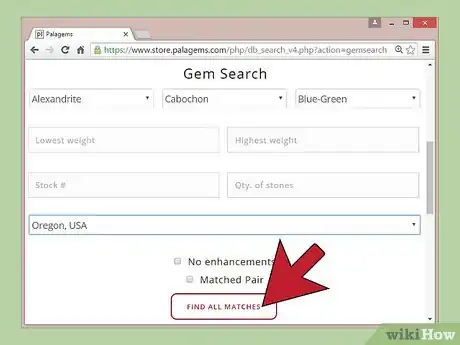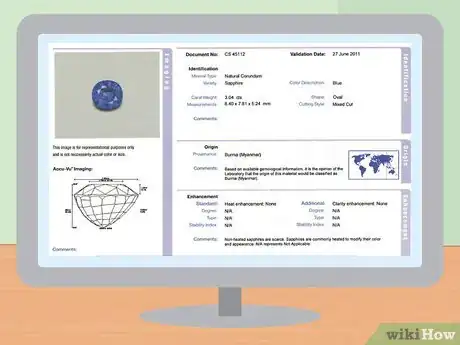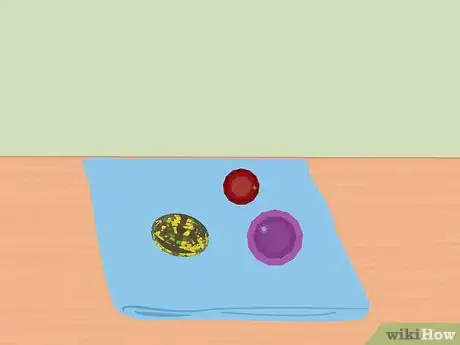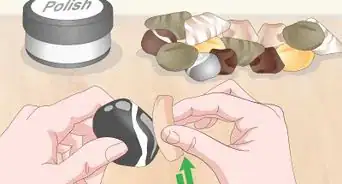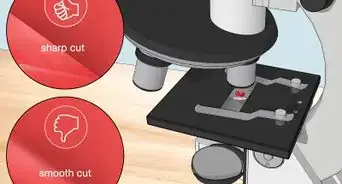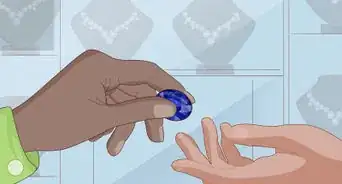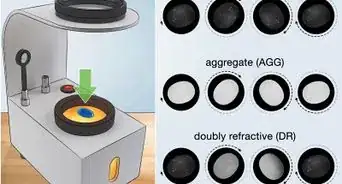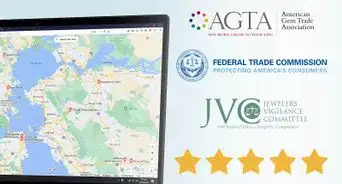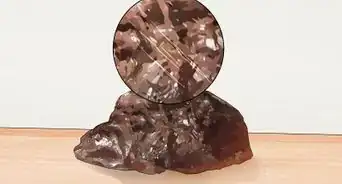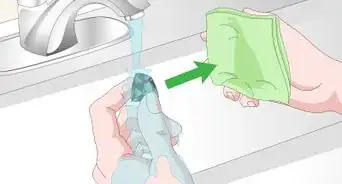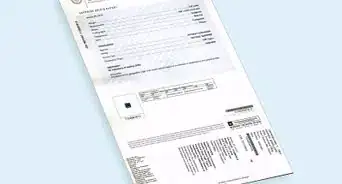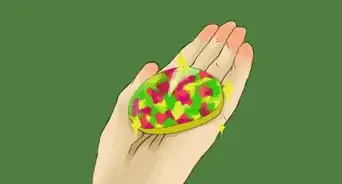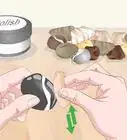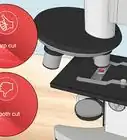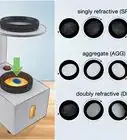This article was co-authored by Jerry Ehrenwald. Jerry Ehrenwald, GG, ASA, is a graduate gemologist in New York City. He is the previous President of the International Gemological Institute and the inventor of U.S.-patented Laserscribe℠, a means of laser inscribing onto a diamond a unique indicia, such as a DIN (Diamond Identification Number). He is a senior member of the American Society of Appraisers (ASA) and is a member of the Twenty-Four Karat Club of the City of New York, a social club limited to 200 of the most accomplished individuals in the jewelry business.
There are 11 references cited in this article, which can be found at the bottom of the page.
This article has been viewed 67,781 times.
Gemstones have long been treasured as brilliant and attractive works of nature. For as long as they’ve been labeled “gemstones,” there have been enthusiasts aiming to collect them all. Gemstones make for a unique collectible, as they are gorgeous in their own right while also being a desirable investment opportunity. Whether your reasons for collecting are monetary or otherwise, gem collecting is a rewarding hobby that’s simple to get into.
Steps
Beginning your Collection
-
1Decide your reasons for collecting. Since collecting gemstones is such a versatile hobby, there may be some differences in design when people first begin to collect gemstones. It’s important to know what you want out of collecting before you begin to collect. For most people, this will simply be a choice between collecting for fun or attempting to collect as a source of investment.[1]
- If you’re choosing to collect as an investment, know ahead of time how much time and money you’re willing to spend. Those will be the factors which most influence your collecting.
- If you’re collecting out of interest, then collecting will be a matter of choosing what you like best. You might consider centering your starting collection around a certain theme, like color or location of origin.
-
2Search for gemstones in nature. While the idea of finding gemstones in the wild may summon images of mine shafts and cave formations, there are actually a number of ways and places where anyone can look for gemstones. Unless you’re lucky most locations with public digs will require a bit of a trip, so plan ahead if you’re hoping to visit a dig site.[2]
- Those who are collecting as an investment will want to stay away from public digs. Gemstones worth investing in will need to be considerably more rare than those found at public dig sites.
- Also, those who are looking to collect especially exotic or scarce gemstones may want to look elsewhere. Public digs will usually only involve more common gemstones, such as emeralds, sapphires, and diamonds.[3]
- To find dig sites, look online. Alternatively, you can seek out local geological/gemological societies and organizations for any recommendations.
- Prepare for anything when it comes to these public digs. Some are sheltered and have you sitting and sifting, others have you entering caves with full equipment.
Advertisement -
3Learn to identify gemstones. Certainly a perk for the gem enthusiast, collecting gems will require you to possess or begin to possess a familiarity with gemstones. Even the shrewd investment collector will prefer to be able to at least somewhat identify gemstones they see in person.
- Identifying gemstones will require some equipment: tweezers, a loupe (glass eye, usually with 10x magnification), and some light source.
- More advanced identifying techniques may require a refractometer or polariscope. This is why it is always a good idea to form a good relationship with a dealer; a friendly dealer may lend their expertise and equipment when you’ve got something that needs identifying.
- Fortunately the most basic assessments can be done with the naked eye by examining the gem’s color by analyzing its hue (base color), tone (depth of color), and saturation (strength of color).
Buying Gemstones
-
1Decide what to buy. Though only a serious concern for investment collectors, it’s never a poor choice to decide what you’d like to purchase ahead of time. Of course what you choose to buy will ultimately be decided by how much you’re willing to spend; this is something that, mentioned previously, is also helpful to know ahead of time.[4]
- Collectibility (and value) in gemstones is almost always decided by rarity. While rarity may not always mean expensive to purchase, rarity will mean consistency of value--gems which are rare now will only become more rare.
- In that vein, gemstones you’ll want to look for if you’re an investor are those which are especially rare in occurrence, or more common gems with uncommon traits (such as “unheated” gems or unusual colors like yellow sapphire).
- Again, don’t purchase the most expensive gems you can find in the hopes of them being more expensive later on. The gem market is unusually receptive to short-lived trends, and certain gems may receive artificial price boosts which fail to last.
-
2Buy gems online. As one might imagine, a growing number of gem dealers are expanding or altogether moving their operations online. The most important thing to be aware of when shopping online (for gems or anything else) is to be aware of anything that looks illegitimate or untrustworthy.
- Normally you’ll want sites that have a good selection, as well as a photograph along with everything they sell. Never buy from a site which doesn’t allow returns; too often you’ll find gems in-person won’t match their online photographs.
- While there are a host of legitimate sites online, a few reputable choices with broad selections are: http://www.multicolour.com and http://www.palagems.com.
- It’s not a bad idea to choose a few sites to build a lasting relationship with; it often becomes easier to do business with dealers that know you better.
-
3Buy gems in person. While gems are going the way of so many other commodities and transitioning into online sales, there are still plenty of places to find gems for sale. If you’re fortunate you may have a gem collector’s shop in your own town. While these rarely contain a large selection for sale, they are a good base for trade talk and advice.
- The most reliable and active scene for purchasing gems in person will be trade fairs. Usually traveling or part of temporary flea markets, these are usually groups of several vendors looking to sell.
- Be aware that there’s often a culture of haggling at these gatherings; be prepared to have to talk some prices down.
- Like online stores, it helps to build relationships with any dealers you find reliable, especially if you’re looking for certain gems in particular. A good dealer can provide insight into the smaller gem mining/processing community.
-
4Buy for your hobby. Those collectors who are out for sheer interest need not hunt down the most refined and reputable dealers for their gemstones. Far from suggesting anything illegitimate, hobby collectors should consider other avenues, such as informal online trading, for their gem purchases.
- Since hobby collectors generally have specific stones in mind which might not fall in the rare or expensive category, casting a wider net can be very helpful.
- If you have a specific gemstone in mind, don’t hesitate to try and reach out to others on Craigslist or gemstone collecting forums online. Plenty of communities will already have an ad-hoc trading environment set up.
- Trade fairs will also have a fair amount for hobby collectors to appreciate. It’s also a good idea for hobby dealers to build relationships with certain dealers, many of whom are willing to keep their eyes out for specimens you have in mind.
-
5Demand a grading report with every gem. Part of ensuring the integrity of your collection, whether you’re seriously invested or not, will be to have some assurance that the gemstones you own are, in fact, the gemstones you believe them to be. Fortunately there exist organizations which provide these sort of reports, and established dealers will already be well-acquainted with them.[5]
- The most common and definitive is the American Gemological Laboratory (AGL) Colored Stone Grading Report. Be sure to get one of these with every colored stone purchase, especially those whose location is of importance (such as Kashmir sapphires).
- Diamonds have their own report from the Gemological Institute of America; it is highly recommended to have one with every diamond purchase as their reports are unique and undisputed.
- Gemological laboratories will grade your stones, but they won't assign a monetary value. That's what appraisers are for.[6]
-
6Join a gemstone society. Like many other collectibles, gemstones have formed multiple organizations surrounding the collection and maintenance of gemstones. The two biggest names in this regard are the International Gem Society and the American Gem Society.[7]
- Membership in either grants you access to their collective knowledge in the form of articles, courses, and meetings.
- Usually memberships will also grant you certain preference with affiliated dealers as well as access to certain gem labs for identification.[8]
Maintaining Your Collection
-
1Purchase gemstone insurance. For those collectors who are also serious investors, obtaining insurance to cover your gemstone collection is a must. Some might think that homeowner’s or renter’s insurance will adequately cover their collection. Unfortunately this protection is usually very limited, and often excludes jewelry. If it doesn’t, it might demand the use of certain replacement firms.[9]
- Be sure you know what you want out of your insurance before purchasing--how much risk do you need covered? Will you want third-party damage (in the care of a dealer, for example) covered?
- Inquire whether or not any policy you’ll be purchasing covers “mysterious disappearances.” If your gems are missing and you’ve no evidence of a robbery, you might not be covered if only insured against theft.
- See if there are any discounts to be had for safe-keeping of the gemstones, or for guarantees that certain gems never leave your home.
- Always shop around. Any policy that doesn’t seem to be a good fit is worth walking away from. Keep looking for a policy that will fit your life and budget.
-
2Have a safe storage place. Even for the most casual collector, gemstone collections can quickly grow in value. It’s important to have a place that’s especially secure in which to store your collection. While it’s tempting to always have the most impressive gems on display, consider doing so only when you know they’ll be seen and store them the rest of the time.
- For the home, there’s usually no safer choice than a safe itself. General wisdom concerning safes recommends you keep them in an obscure area like a closet, and keep them bolted to the floor.
- Those collectors who have invested in very expensive pieces may want to consider a safety deposit box for added security.
- Unless specific pieces are especially large, everyone (from the most serious investor to someone just beginning) will keep their gems in small, circular foam inserts set inside “gem jars” which are shallow plastic cases.
- These are always available online, usually in groups of 20 to 50+.
- If you’d like to label your gems, it’s best to do so on the outside of any one gem jar, as opposed to appending anything to the gem itself.
-
3Clean the gems before storage. While we may associate gemstones with a sort of sterile beauty, the truth is that they’ve been handled repeatedly in their journey from stone to you. In that process the gemstone will have built up with oil and grime which may not be visible with the naked eye. If left dirty, gems can wear over time and lose definition and luster. Be sure to avoid this by properly cleaning any gems before storing them.[10]
- Different gemstones will require different methods of cleaning, visit https://www.gemsociety.org/article/care-maintenance-gemstones/ for a comprehensive list of gemstones and the proper ways to clean them.
- While they will differ, the vast majority of cleaning methods will involve a soft cloth and non-abrasive detergent or soap.
-
4Keep a catalog of your collection. Once you’ve continued with your collection for some time, you may find yourself struggling to keep track of everything you have. For the serious investor, a catalog is a must-have for financial and legal records. Keeping a thorough catalog is a good habit to begin early so that it’s never too much of a burden to create one.[11]
- Electronic catalogs made with programs like Microsoft Excel will be the best for this. A single physical catalog is subject to damage or loss; keeping it electronic will assure availability.
References
- ↑ http://www.preciousgemstones.com/GEMCOLLECTINGTWO.HTML#Ten%20Rules%20For%20Gem%20Collecting
- ↑ https://www.gemsociety.org/article/mined-in-america/
- ↑ http://www.gemworld.com/assets.asp
- ↑ https://www.gemsociety.org/article/investing-in-gems/
- ↑ http://www.gia.edu/gem-lab-service/colored-stone
- ↑ Jerry Ehrenwald. Former President, International Gemological Institute & Graduate Gemologist. Expert Interview. 12 August 2019.
- ↑ https://www.gemsociety.org/
- ↑ https://www.americangemsociety.org/
- ↑ https://www.gemsociety.org/article/is-my-insurance-company-cheating-me/




